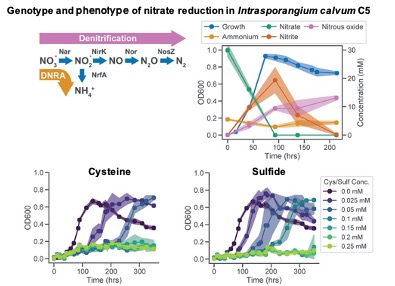JANUARY 2021
Using systems analysis to elucidate the roles that hydrogen sulfide and cysteine play in inhibiting the growth of a nitrate-reducing
Otwell AE, Carr AV, Majumder ELW, Ruiz MK, Wilpiszeski RL, Hoang LT, Webb B, Turkarslan S, Gibbons SM, Elias DA, Stahl DA, Siuzdak G, Baliga NS. 2021. Sulfur metabolites play key system-level roles in modulating denitrification. mSystems 6:e01025-20. https://doi.org/10.1128/mSystems.01025-20.

The Science
Intrasporangium calvum C5 is a nitrate-reducing bacterium (NRB) isolated from soil. We discovered that its growth is inhibited by certain reduced sulfur compounds, including sulfide. Sulfide is produced by sulfate-reducing bacteria (SRB). To determine how reduced sulfur compounds are causing inhibition in I. calvum, we compared transcriptomes (total mRNA) and metabolomes (total metabolites) across regular and inhibition conditions. This led to the identification of specific metabolic pathways that were impacted by the inhibitory compounds, including biosynthesis of amino acids and carbon utilization.
The Impact
NRB and SRB coexist in diverse anoxic environments, including soil, groundwater, and wastewater. Their interplay and activities have major implications on the global cycling of nitrogen and sulfur species. For example, the removal of reactive nitrogen species by NRB is desirable for wastewater treatment, but in agricultural soils, NRB can drive the conversion of nitrates from fertilizers into nitrous oxide, a potent greenhouse gas. By characterizing how reduced sulfur compounds inhibit the growth and activity of NRB, we have gained systems-level and mechanistic insight into the factors that impact the interactions and therefore activity of NRB and SRB in the environment.
Summary
Competition between NRB and SRB for resources in anoxic environments is thought to be governed largely by thermodynamics. It is now recognized that intermediates of nitrogen and sulfur cycling (e.g., hydrogen sulfide, nitrite, etc.) can also directly impact NRB and SRB activities in freshwater, wastewater, and sediment and therefore may play important roles in competitive interactions. Here, through comparative transcriptomic and metabolomic analyses, we have uncovered mechanisms of hydrogen sulfide- and cysteine-mediated inhibition of nitrate respiratory growth for the NRB Intrasporangium calvum C5. Specifically, the systems analysis predicted that cysteine and hydrogen sulfide inhibits the growth of I. calvum C5 by disrupting distinct steps across multiple pathways, including branched-chain amino acid (BCAA) biosynthesis, utilization of specific carbon sources, and cofactor metabolism. We have validated these predictions by demonstrating that complementation with BCAAs and specific carbon sources relieves the growth inhibitory effects of cysteine and hydrogen sulfide. These mechanistic insights give new context to the interplay and stratification of NRB and SRB in diverse environments.
Contact
Nitin S. Baliga
Senior Vice President, Director, and Professor
Institute for Systems Biology, Seattle, WA
